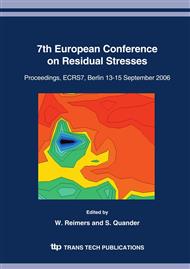p.531
p.537
p.543
p.549
p.555
p.563
p.569
p.575
p.581
Application of Hole-Drilling Method in Practice
Abstract:
Residual stresses can arise in engineering components as part of their manufacturing or can also be introduced deliberately as part of surface treatment procedures. A precise knowledge of the level of residual stresses that exist in engineering components is necessary in analysis and quality control as well as for accurate prediction of components lifetime. Therefore, reliable methods of determining the magnitude and distribution of residual stresses are required in order to quantify their effect and to avoid detrimental failures. On the other hand on-site portable and nonor near non-destructive methods are required for practical use. The hole-drilling method shows a great potential in measuring and evaluating residual stresses in practical applications. This paper presents results and problems on residual stress measurements performed by the holedrilling method on real components, including forming applications of rolling, punching and cutting, and machine component applications of gears and shafts. Presented results clearly indicate the importance of residual stress information for proper design and use of engineering components.
Info:
Periodical:
Pages:
555-560
Citation:
Online since:
September 2006
Authors:
Keywords:
Price:
Сopyright:
© 2006 Trans Tech Publications Ltd. All Rights Reserved
Share:
Citation:


